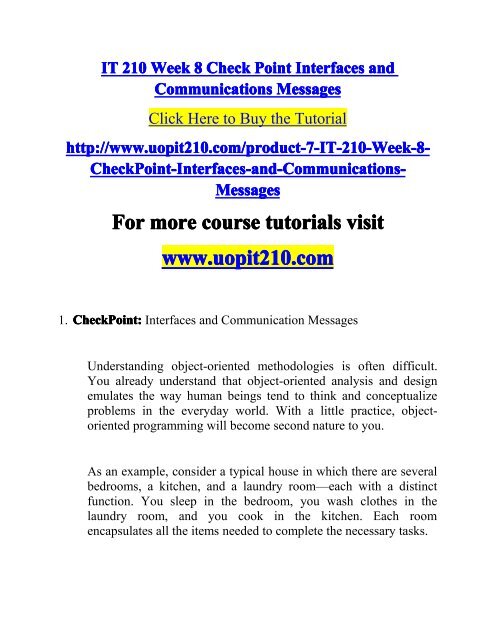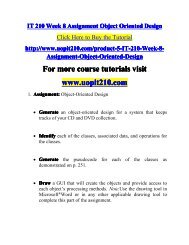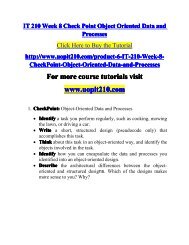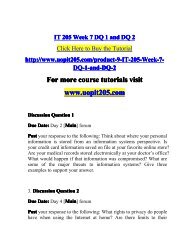IT 210 Week 8 CheckPoint Interfaces and Communications Messages
For more course tutorials visit www.uopit210.com 1. CheckPoint: Object-Oriented Data and Processes • Identify a task you perform regularly, such as cooking, mowing the lawn, or driving a car. • Write a short, structured design (pseudocode only) that accomplishes this task. • Think about this task in an object-oriented way, and identify the objects involved in the task.
For more course tutorials visit
www.uopit210.com
1. CheckPoint: Object-Oriented Data and Processes
• Identify a task you perform regularly, such as cooking, mowing the lawn, or driving a car.
• Write a short, structured design (pseudocode only) that accomplishes this task.
• Think about this task in an object-oriented way, and identify the objects involved in the task.
Create successful ePaper yourself
Turn your PDF publications into a flip-book with our unique Google optimized e-Paper software.
<strong>IT</strong> <strong>210</strong> <strong>Week</strong> 8 Check Point <strong>Interfaces</strong> <strong>and</strong><strong>Communications</strong> <strong>Messages</strong>Click Here to Buy the Tutorialhttp://www.uopit<strong>210</strong>.com/product-7-<strong>IT</strong>-<strong>210</strong>-<strong>Week</strong>-8-<strong>CheckPoint</strong>-<strong>Interfaces</strong>-<strong>and</strong>-<strong>Communications</strong>-<strong>Messages</strong>For more course tutorials visitwww.uopit<strong>210</strong>.com1. <strong>CheckPoint</strong>: <strong>Interfaces</strong> <strong>and</strong> Communication <strong>Messages</strong>Underst<strong>and</strong>ing object-oriented methodologies is often difficult.You already underst<strong>and</strong> that object-oriented analysis <strong>and</strong> designemulates the way human beings tend to think <strong>and</strong> conceptualizeproblems in the everyday world. With a little practice, objectorientedprogramming will become second nature to you.As an example, consider a typical house in which there are severalbedrooms, a kitchen, <strong>and</strong> a laundry room—each with a distinctfunction. You sleep in the bedroom, you wash clothes in thelaundry room, <strong>and</strong> you cook in the kitchen. Each roomencapsulates all the items needed to complete the necessary tasks.
You do not have an oven in the laundry room or a washingmachine in the kitchen. However, when you do the laundry, you donot just add clothes to the washer <strong>and</strong> wait in the laundry room;once the machine has started, you may go into the kitchen <strong>and</strong> startcooking dinner. But how do you know when to go back to checkthe laundry? When the washer buzzer sounds, a message is sent toalert you to go back into the laundry room to put in a new load.While you are folding clothes in the laundry room, the oven timermay ring to inform you that the meat loaf is done.What you have is a set of well-defined components: Each providesa single service to communicate with the other components usingsimple messages when something needs to be done. If youconsider a kitchen, you see it is also composed of several, smallercomponents, including the oven, refrigerator, <strong>and</strong> microwave. Toplevelobjectsare composed of smaller components that do the actualwork. This perspective is a very natural way of looking at ourworld, <strong>and</strong> one with which we are all familiar. We do the samething in object-oriented programming:o Identify components that perform a distinct serviceo Encapsulate all the items in the component necessary to getthe job doneo Identify the messages that need to be provided to the othercomponentsAlthough the details can be quite complex, these details are thebasic principles of object-oriented programming.• Consider the microwave oven in your kitchen, using the objectorientedthinking described above.
• Create a table with the following four column headings: Top-Level Objects, Communicates With, Incoming <strong>Messages</strong>, <strong>and</strong>Outgoing <strong>Messages</strong>.o Identity the top-level objects of the microwave.o Explain some of the graphical user interfaces (GUIs) <strong>and</strong>communications messages that occur during the operation ofa microwave.• Describe some of the advantages of having a componentizedsystem. For example, what happens if the microwave breaks?• Post your completed <strong>CheckPoint</strong> as an attachment.
















